|
What can be more American than mom and apple pie? Well, for many hungry Americans the answer is our classical favorite: burgers and fries. Unlike some other famous pairs in American history, such as Abbott and Costello, Lewis and Clark, Donnie and Marie, and Simon and Garfunkel, burgers and fries marched forward across the Millennium frontier and into the 21st Century with just as strong a following as ever. Whether served with cheese, lettuce, tomato, "hold the onion", pickles, ketchup, mayonnaise, or mustard, we know where the beef is: between two slices of fresh bun and next to an extra large order of crispy golden fries.
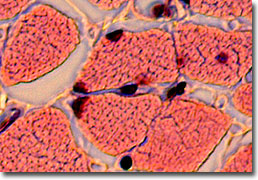
Cooked Meat Thin Section
Grilled, fried, charbroiled, barbecued, or even microwaved, patties of beef, pork, lamb, venison, turkey, and veal grace millions of Americans' dinner plates every day. But wait, you say you're a vegetarian? Not to worry. The wide availability of processed food products, such as soybean patties and tofu, allow even the meatless to enjoy the taste of the quintessential burger and fries...at least sort of. More properly known as the hamburger, this sandwich had its origins not in the United States, but rather in medieval Eurasia. It all started with the Tartars, who were not only seasoned wandering warriors, but also frugal gourmets that shredded their low quality beef to produce the world's first burgers. Legend has it that they tenderized this tough meat by placing it under a horse's saddle, thereby flattening it into a patty. Sometime prior to the fourteenth century, the Russian Tartars introduced their coveted shredded beef dish into Germany. Intuitive Germans mixed in regional spices and the beef was eaten either cooked or raw, particularly among the lower classes that could not afford prime cuts of meat. An Irishman dubbed the dish the "Hamburg steak" during his visit to Hamburg, Germany. It is rumored that the Irishman, by chance, was an ancestor of President John F. Kennedy, and thus the hamburgers' first link to the New World.
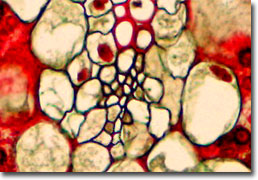
Onion Tissue
The hamburger traveled to England and met up with Dr. J.H. Salisbury, a popular food reformer and physician who preached that shredding all foods before consumption improved digestibility. Salisbury prescribed eating beef three times a day (washed down with hot water) and thus, the Salisbury steak was born. About the same time (in the 1880s), German immigrants arrived at Ellis Island, bearing dreams of streets paved in gold and with a craving for their hamburger steak, which was by then shortened to hamburger. Origins of the bun that transforms the hamburger into a sandwich are a bit more mysterious. By the 1904 World's Fair in St. Louis, the culinary delight was a featured sandwich, known as the "Hamburg". Some claim that Louis Lassen created a new meat sandwich in 1900, called the "Hamburger", to use up the trimmings from the Hamburg steak sandwich he featured at his lunch wagon in New Haven, Connecticut. Still others firmly believe that their gastronomic delight was invented by Charlie Nagreen, a peddler who sold the sandwiches in 1885 at the Outagamie County Fair in Seymour, Wisconsin. Regardless of which story holds gravy, just pass the mustard.
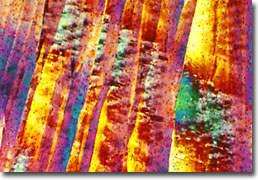
Birefringence in Crystallized Cheese Proteins
But you ordered fries with that burger and it is getting cold after this long discourse on the warm trail of the hamburger's origins. French fries: are they French? Mais oui, and why not? Reportedly Thomas Jefferson brought the recipe back to the Colonies from France in the late 1700s and named them as "potatoes, fried in the French manner". A nom de plume far too long and complicated for patrons of today's fast-food joints, the name was shortened to an understandable "French fries". In France, they are still known as "pommes frites" (derived from "pommes de terre" or apples from the ground—potatoes) and in Great Britain as "chips," where they have been known to bathe in malt vinegar instead of ketchup. Others contend the name has nothing to do with country of origin, but rather how the potato strips are cut or "frenched".
Predating the potato chip and considered the dietary equivalent to sit-com television, the much-maligned French fry has been attacked by dieticians, doctors and parents for decades, but still thrives in the minds, mouths, and stomachs of America's children. Whether standard cut, shoestring, steak-cut, waffle-cut, spiral-cut, or even breaded or coated with cheese ("cheese fries") and chili, the aroma of French fries cooking in greasy oil draws hungry throngs to restaurants and home kitchens around the world. Usually served salted and with ketchup (or sometimes mayonnaise) as a condiment, French fries consume more than 7.5 percent of the United States' huge potato crop. Potatoes are cut into strips, soaked in cold water, blotted dry, and deep-fat fried until crisp and golden brown. There is even a Web site dedicated to French fries and the mysteries that they hold. Pass the ketchup, please.
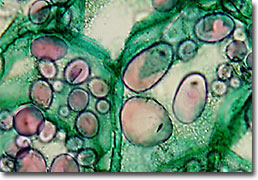
Starch Granules in Potato Tissue
Mass distribution in the United States of the fast-food hamburger (known as "sliders" in Chicago and throughout the Midwest) started with White Castle in 1921. Forty years later those same folks brought us the cheeseburger, marrying the ground beef patty with a slice of cheese, but that's another story (our question is: why did it take forty years for the fast-food gurus to slap a piece of cheese on a burger?). Originally sold for a nickel each, the little square burgers were grilled with onions packed inside and sporting telltale holes to accelerate cooking times, eliminating the need for flipping. By the 1930s, drive-in restaurants hit the scene (a thriving icon to teen American pop culture), allowing diners to remain in their cars and forever changing the landscape of hamburgers and fries.
Following White Castle's grease trail were Wimpy Burger, Bob's Big Boy (the first double patty burger), and finally in 1948, the ubiquitous Ronald McDonald's. The first McDonald's, however, did not sell hamburgers, because it was exclusively a hot dog stand. Ray Kroc, the creator of the McDonald's worldwide empire, joined the team in 1954 and changed the stakes once again. Kroc's ingenuity and creative marketing led to the Big Mac, a well-adorned triple-decker hamburger sandwich (referred to by some as a "gut grenade") that launched an assault on the palates and stomachs of Americans in 1968. A wide spectrum of national competitors continuously nips at McDonald's hoofs (such as Hardee's, Wendy's, and Burger King), but none have enjoyed the widespread success of this truly-American icon.
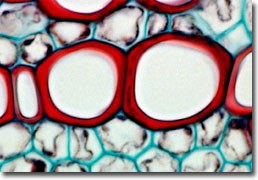
Lettuce Tissue
With an increased awareness towards healthy nutrition and recent scares from Mad Cow disease, Hoof-and-Mouth virus, runaway cholesterol levels, mass obesity, and burger contamination threats by Listeria and E. coli, chicken-pushing upstarts like Popeye's, Kentucky Fried Chicken, and Chic-Fil-A have made inroads into McDonald's mainstay and America's favorite sandwich. Even McDonald's, the high temple of ground beef, has taken to selling Chicken McNuggets and yes, gulp, lean, broiled chicken breast sandwiches. But don't fret, the hamburger and its companion fries, will certainly stay at the top of American's favorite foods list for many years to come. But that's enough writing, we've got to hoof it to the nearest fast-food drive-in for a warm and juicy burger 'n fries.
|

